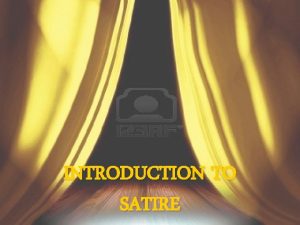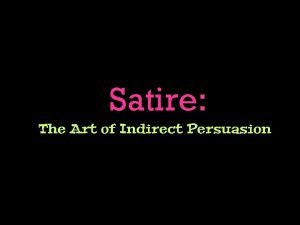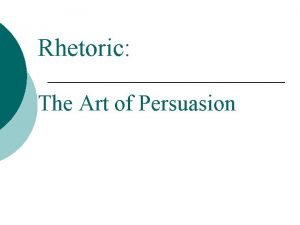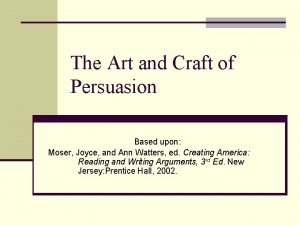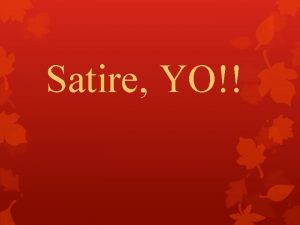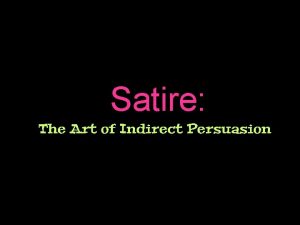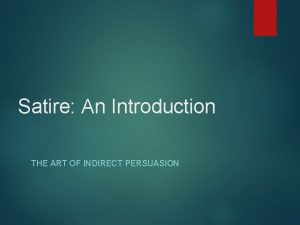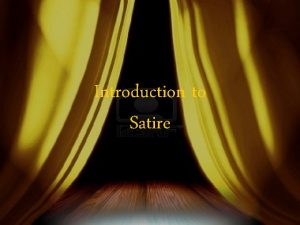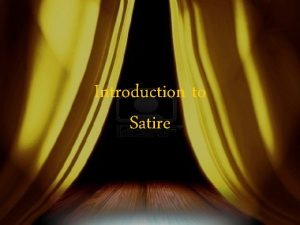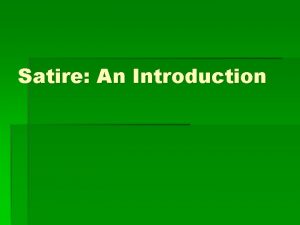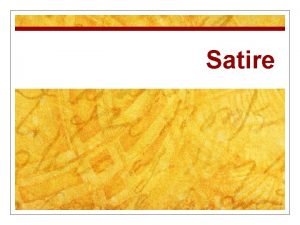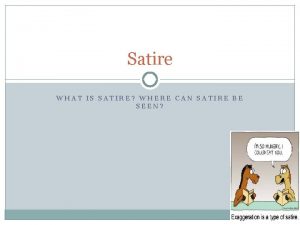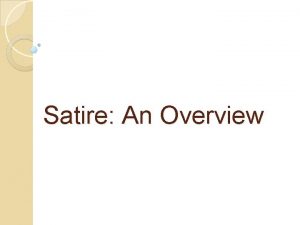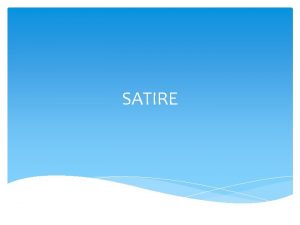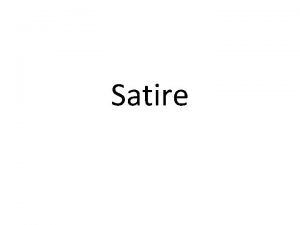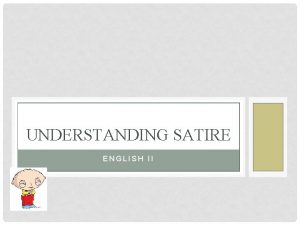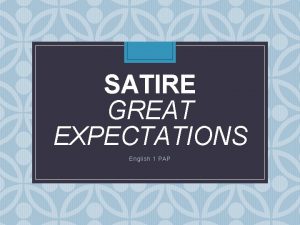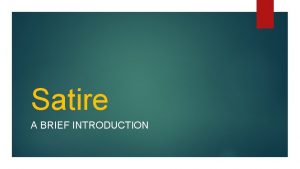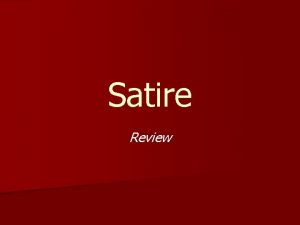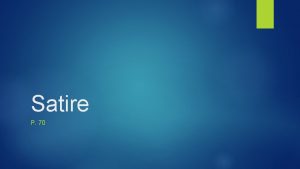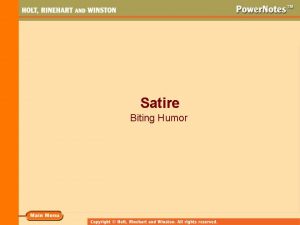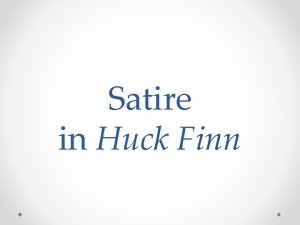Satire Sat The Art of Indirect Persuasion What

































- Slides: 33

• Satire: Sat • The Art of Indirect Persuasion

What is the artist alluding to in this cartoon? What message is being implied? Is the implication effective? Why or why not?

The Art of Indirect Persuasion � If you’ve ever enjoyed watching late-night comedy shows, you know how effective and fun this approach can be when it comes to changing perception of the subject or topic being lampooned. � In this unit, you’ll immerse yourself in the art of satire, exploring how writers use a range of genre and technique, including the one you are most aware parody, to present their messages in indirect ways.

The Art of Indirect Persuasion � Additionally, you’ll explore how diction and syntax can be used to create humor as well as a wide range of satirical tones. � Finally, you’ll explore how satirists manipulate and parody the conventions and content of other formats and genre to advance their purpose as writers.

Satire � a literary genre that uses irony, wit, and sometimes sarcasm to expose humanity’s vices and foibles, giving impetus, or momentum, to change or reform through ridicule. � It is a manner of writing that mixes a critical attitude with wit and humor in an effort to improve mankind and human institutions. � It is important to note that satire aims to change behaviors or traits that ARE changeable – not to poke fun at things which might not be changeable (like a physical trait)

Satire � While some writers and commentators use a serious tone to persuade their audiences to accept their perspective on various issues, some writers use humor to convey a serious message.

Types of Satire � Horatian satire pokes fun at human foibles with a witty, playful, even indulgent tone. � Juvenalian satire denounces a human or societal vice/error with an invective and abrasive tone. It can often be considered “cringe worthy”

Which of these is more Horatian? Which is Juvenalian?

Horatian Satire � This type of satire is named after the Roman satirist Horace. � It seeks to lightly criticize or jab (rather than attack) immorality or stupidity. � In general, Horatian satire is gentler, more sympathetic, and more tolerant of human folly. � Unlike Juvenalian satire, it serves to make us laugh at human folly as opposed to holding our failures up for needling. � Horatian satire tends to ridicule human folly in general or by type rather than attack specific persons. � It tends to produce a smile.

Horatian Satire Thanksgiving Miracle

Juvenalian Satire � This type of satire is named after the Roman satirist Juvenal. � It is harsher than Horatian satire because it often attacks and shows contempt for people. � Often, it seeks to address some evil in society through scorn and ridicule. � The Juvenalian satirist approaches his work in a more serious manner and uses dignified language to attack erroneous thinking or vice. � In this way Juvenalian satire evokes feelings of scorn, shock, and righteous indignation in the mind of the reader. � It rarely produces a humorous effect – it can make a reader cringe

Juvenalian Satire Outsourcing Childcare

Characteristics of Satirical Writing � The following slides describe the various characteristics that often appear in satirical writing. � As you read the literature in the remainder of this unit, your goal will be to identify and analyze these characteristics and their effect on the various text.

Incongruity � to present things that are out of place or are absurd in relation to its surroundings.

Reversal or Irony � Reversal to present the opposite of normal order. (the order of events, hierarchal order, gender roles � Irony to present the opposite of what the reader/viewer might expect to happen. The surprise recognition by the audience often produces a comic effect, making irony often funny. � Reversal and Irony are very similar and often interchangeable

Reversal These pictures of from an Instagram page called “Bros Being Basic. ” What is the use of gender reversal satirizing?

Are these Irony or Reversal?

Hyperbole � Hyperbole is deliberate exaggeration to achieve an effect; overstatement.

Hyperbole Substitute Teacher

� � � Understatement and Litotes are a form of understatement that involves making an affirmative point by denying its opposite. Understatements underemphasize the importance Do you see the difference in these? For Example � “Being tortured with fire must have been somewhat uncomfortable. ” � “Rap videos with dancers in them are not uncommon. “ � “There a few Starbucks in America. "

Which are these?

Caricature �A caricature is an exaggeration or other distortion of an individual's prominent features or characteristics to the point of making that individual appear ridiculous. � The term is applied more often to graphic representations than to literary ones.

Caricature

Caricature Hillary Clinton Campaign Ad

Wit � Wit is most commonly understood as clever expression, whether aggressive or harmless; that is, with or without derogatory intent toward someone or something in particular. � We also tend to think of wit as being characterized by a mocking or paradoxical quality, evoking laughter through apt phrasing.

Wit

Wit Word Crimes - Weird Al

Sarcasm � Sarcasm is intentional derision, generally directed at another person and intended to hurt. � The term comes from a Greek word meaning “to tear flesh like dogs” and signifies a cutting remark. � Sarcasm usually involves obvious, verbal irony, achieving its effect by jeeringly stating the opposite of what is meant so as to heighten the insult.

Sarcasm

Parody �A parody is an imitation of an author or his/her work with the idea of ridiculing the author, his/her ideas, or the work itself. �A parodist exploits the peculiarities of an author’s expression—the propensity to use too many parentheses, certain favorite words, or other elements of the author’s style.

Parody The Netherlands Welcomes Trump

Fallacious Reasoning One of the tools used most predominately in satire involves the VERY THING you should avoid in your own argument…the use of fallacies. This purposeful fallacious reasoning adds to the SATIRICAL ARGUMENT. Make sense? ? ? Oversimplification Either/Or Poisoning the Well Sweeping Generalization

• Most Common Fallacies Used in Satire • How many of these do you know? • Poisoning the Well • Sweeping generalization • Hasty generalization Most • Faulty Cause and Effect • Slippery slope • Oversimplification • Ad Misericordam (appeal to pity) • False analogy • Red Herring • Either/Or • False Credibility • Bandwagon
 Verbal irony in shrek
Verbal irony in shrek Indirect satire
Indirect satire Which greek philosopher defined the art of persuasion
Which greek philosopher defined the art of persuasion Rhetoric the art of persuasion
Rhetoric the art of persuasion The art and craft of persuasion
The art and craft of persuasion Indirect satire definition
Indirect satire definition Hát kết hợp bộ gõ cơ thể
Hát kết hợp bộ gõ cơ thể Ng-html
Ng-html Bổ thể
Bổ thể Tỉ lệ cơ thể trẻ em
Tỉ lệ cơ thể trẻ em Chó sói
Chó sói Tư thế worms-breton
Tư thế worms-breton Chúa yêu trần thế
Chúa yêu trần thế Các môn thể thao bắt đầu bằng tiếng nhảy
Các môn thể thao bắt đầu bằng tiếng nhảy Thế nào là hệ số cao nhất
Thế nào là hệ số cao nhất Các châu lục và đại dương trên thế giới
Các châu lục và đại dương trên thế giới Công thức tính thế năng
Công thức tính thế năng Trời xanh đây là của chúng ta thể thơ
Trời xanh đây là của chúng ta thể thơ Cách giải mật thư tọa độ
Cách giải mật thư tọa độ Làm thế nào để 102-1=99
Làm thế nào để 102-1=99 độ dài liên kết
độ dài liên kết Các châu lục và đại dương trên thế giới
Các châu lục và đại dương trên thế giới Thể thơ truyền thống
Thể thơ truyền thống Quá trình desamine hóa có thể tạo ra
Quá trình desamine hóa có thể tạo ra Một số thể thơ truyền thống
Một số thể thơ truyền thống Cái miệng xinh xinh thế chỉ nói điều hay thôi
Cái miệng xinh xinh thế chỉ nói điều hay thôi Vẽ hình chiếu vuông góc của vật thể sau
Vẽ hình chiếu vuông góc của vật thể sau Biện pháp chống mỏi cơ
Biện pháp chống mỏi cơ đặc điểm cơ thể của người tối cổ
đặc điểm cơ thể của người tối cổ Thế nào là giọng cùng tên
Thế nào là giọng cùng tên Vẽ hình chiếu đứng bằng cạnh của vật thể
Vẽ hình chiếu đứng bằng cạnh của vật thể Phối cảnh
Phối cảnh Thẻ vin
Thẻ vin đại từ thay thế
đại từ thay thế
